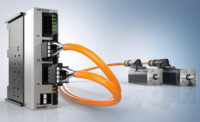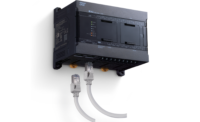Machinery
It’s all about Tension Control
If there was ever a time to employ waste-reducing technologies, it is now, and precise tension control and automatic roll changing are technologies that go hand in hand.

In addition to the difficulties of procuring sufficient roll stock, we’re all struggling at some level with hiring, training and retaining talent. This leaves associates with more tasks to do and less time to do it, which makes it more important to use automated roll changing with tension control that is easy to use, easy to understand and easy to maintain.
Printers and converters know that controlling tension in the web is essential to the quality of the product. Web tension upsets between, for example, an unwinding roll and the process may have several causes, including braking of the running roll, splicing action, acceleration of the new roll after splicing, and out-of-roundness or imbalance in the roll.
One trend we continue to mark is the ever-increasing speeds at which converters are looking to operate. In narrow web label and flexible packaging, for example, where speeds of 300 - 500 ft/min (90 – 150 m/min) were once considered fast, OEMs are rating new printing and converting lines at 750 or 800 ft/min (230 – 250 m/min) and higher. Running speeds of new paperboard presses start at 2000 ft/min (600 m/min) and work up from there. At those speeds, it doesn’t take long at all for a tension control issue to ruin thousands of linear feet of expensive stock.
Machine designers must therefore consider the characteristics of the web, the weight of the roll, the mass of the system and the capability of downstream press equipment, as well as the set tension and tension control requirements of the process. A dancer system using the principle of inertia compensation effectively absorbs tension upsets and delivers constant web tension to the process.
A typical load cell or transducer system relies on the principle of "sense and correct." It uses a tension-sensing device, for example a transducer roller, and through an appropriate control system, attempts to maintain the output of the sensor constant. This type of system has no "storage," and its response time limits its ability to adjust for rapid changes, so that tension transients are passed along to the process.
An inertia-compensated dancer, however, relies on the principle of "establish and maintain." Tension is established by the dancer, and strictly proportional feedback from its travel is used to maintain the dancer within its stroke. Inertia compensation is achieved by engineering the system components to balance the translational (up and down dancer motion) and rotational (rotating dancer motion) inertias. So, unlike a typical load cell or transducer system, it actually "absorbs" tension disturbances rather than passing them along to the process. The result is consistent web tension.
The introduction of inertia-compensated tension control devices to the coating, printing and converting industries represented a major technical contribution and remain the simplest and most accurate means of delivering constant tension.
Inertia compensation can be applied to any web and nearly any application. It is especially beneficial in processes involving lower tensile strength substrates — such as nonwovens and extensible films — where an inertia-compensated dancer absorbs tension spikes that could otherwise lead to neck down or permanent deformation of the web. Customers can control tension to within +/- 0.25 pounds (1.1 Newtons) total variation without the need for complex control logic.
When putting together splicer specifications, engineers should be able to select from several standard festoon configurations with different web storage and acceleration profiles. Depending on the application, some accumulators include a separate inertia-compensated dancer to provide infeed-quality tension control to the process. One example is the Martin festoon and dancer systems which is also retrofittable, both as a means of increasing the speed of existing processes and for improved web handling of lighter or thinner materials.
By using simple principles of physics, it possible to improve productivity and become commercially more successful.
For more information regarding high-performance splicing, rewinding and tension control systems, visit Martin Automatic Inc. at martinauto.com.
Looking for a reprint of this article?
From high-res PDFs to custom plaques, order your copy today!






